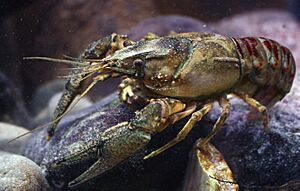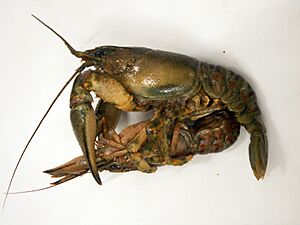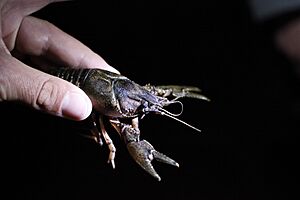Spinycheek crayfish facts for kids
Quick facts for kids Spinycheek crayfish |
|
|---|---|
 |
|
| Conservation status | |
| Scientific classification | |
| Genus: |
Faxonius
|
| Species: |
limosus
|
| Synonyms | |
|
|
The Spinycheek crayfish is a type of crayfish that lives in freshwater. Its scientific name is Faxonius limosus, but it's also known as Orconectes limosus. In German, people call it Kamberkrebs.
This crayfish originally comes from the east coast of North America. You can find it from Quebec in Canada all the way down to the lower James River in Virginia, USA.
Contents
About the Spinycheek Crayfish
The Spinycheek crayfish is a bit unusual. Most crayfish like clear water, but this species can live in silty streams. This means they can survive in water that has a lot of mud or fine dirt mixed in.
Like other crayfish, they are decapods. This means they have ten legs. Two of these legs are large claws that they use for defense and to grab food.
Where Do They Live?
These crayfish live at the bottom of freshwater places. This includes lakes, ponds, and swamps. They prefer areas with flat, sandy, or rocky floors.
Sometimes, you might even spot them outside the water. They can be found on beaches or lawns close to the water's edge. In the water, they use rocks to dig burrows where they can hide.
This species is very common in the northeastern United States and southeastern Canada.
An Unwanted Visitor: Invasive Species
The Spinycheek crayfish has also spread to Europe. This happened when it was brought to Germany in 1890. Since then, it has spread across much of Northern Europe. It has even reached the United Kingdom and as far south as the Danube River in Serbia.
What is an Invasive Species?
When an animal or plant is moved to a new place where it doesn't naturally belong, it can become an "invasive species." This means it can cause harm to the new environment.
The Spinycheek crayfish is a problem in Europe because it carries a disease called crayfish plague. This disease is very dangerous to native European crayfish species. It can wipe out their populations.
Rules in Europe
Because of the problems it causes, the Spinycheek crayfish is on a special list in Europe. Since 2016, it's been on the "Invasive Alien Species of Union concern" list for the European Union.
This means that people in the European Union are not allowed to:
- Import this crayfish.
- Breed it.
- Transport it.
- Sell it.
- Intentionally release it into the environment.
These rules help protect the native crayfish and the natural environment in Europe.
Images for kids






